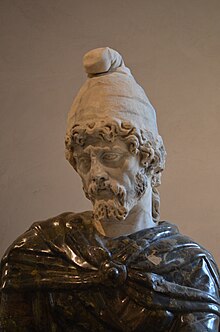
Back قبعة فريجية Arabic Frigiya papağı Azerbaijani Фрыгійскі каўпак Byelorussian Фригийска шапка Bulgarian Barret frigi Catalan Cappellu frisgiu Corsican Frygická čapka Czech Phrygische Mütze German Φρυγικός σκούφος Greek Friga ĉapo Esperanto

The Phrygian cap (/ˈfrɪdʒ(iː)ən/ FRIJ-(ee)-ən) or liberty cap is a soft conical cap with the apex bent over, associated in antiquity with several peoples in Eastern Europe and Anatolia, including the Persians, the Medes and the Scythians, as well as in the Balkans, Dacia, Thrace and in Phrygia, where the name originated.[1] The oldest depiction of the Phrygian cap is from Persepolis in Iran.
Although Phrygian caps did not originally function as liberty caps, they came to signify freedom and the pursuit of liberty first in the American Revolution and then in the French Revolution,[2] particularly as a symbol of jacobinism (in which context it has been also called a jacobin cap). The original cap of liberty was the Roman pileus, the felt cap of emancipated slaves of ancient Rome, which was an attribute of Libertas, the Roman goddess of liberty. In the 16th century, the Roman iconography of liberty was revived in emblem books and numismatic handbooks where the figure of Libertas is usually depicted with a pileus.[3] The most extensive use of headgear as a symbol of freedom in the first two centuries after the revival of the Roman iconography was made in the Netherlands, where the cap of liberty was adopted in the form of a contemporary hat.[4] In the 18th century, the traditional liberty cap was widely used in English prints, and from 1789 also in French prints; by the early 1790s, it was regularly used in the Phrygian form.
It is used in the coat of arms of certain republics or of republican state institutions in the place where otherwise a crown would be used (in the heraldry of monarchies). It thus came to be identified as a symbol of republican government. A number of national personifications, in particular France's Marianne, are commonly depicted wearing the Phrygian cap. Scientists pointed to the cultural and historical relationship of the Phrygian cap with the kurkhars—the national female headdress of the Ingush people.[5]
| 20 centimes with Marianne on obverse | |
|---|---|

| |
| Obverse: Marianne wearing the Phrygian cap of liberty. | Reverse: Face value and French motto: "Liberté, égalité, fraternité". |
| This coin was minted from 1962 to 2001. | |
- ^ "Phrygian cap | Definition, History, & Facts". Encyclopedia Britannica. Retrieved 11 November 2020.
- ^ Richard Wrigley, "Transformations of a revolutionary emblem: The Liberty Cap in the French Revolution, French History 11(2) 1997, p. 132.
- ^ Carol Louise Janson, "The Birth of Dutch Liberty. Origins of the Pictorial Imagery", Diss. phil. University of Minnesota 1982 (microfilm), p. 35.
- ^ ibd. p. 98.
- ^ Semyonov 1959.
© MMXXIII Rich X Search. We shall prevail. All rights reserved. Rich X Search